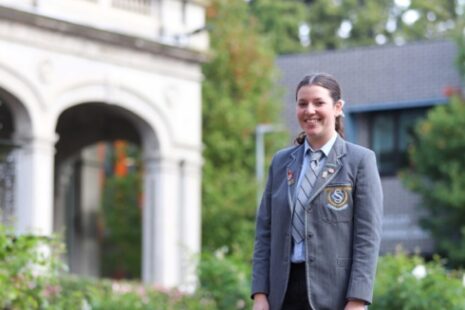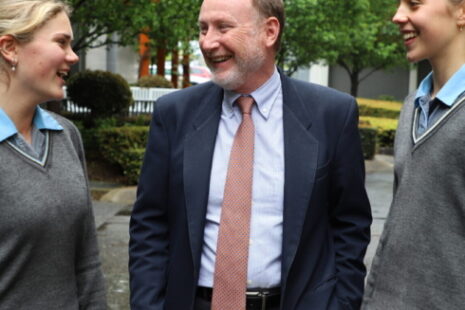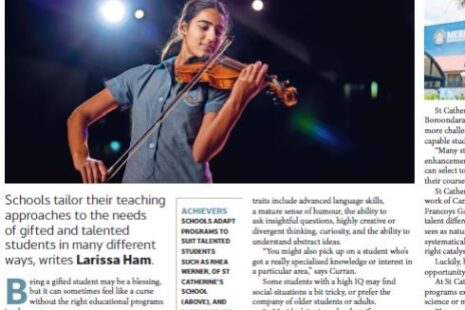She is Strong

Regular readers of the Blue Ribbon will recall my earlier article on author and journalist, Madonna King. King provides insightful reflections into the complexity of educating and raising daughters in the post-COVID world in her podcast hosted by the Alliance of Girls School Australia – recently, rebranded International Coalition of Girls’ Schools. Families may also be familiar with books Madonna King has released in recent years; Being 14, L-Platers and Ten-Agers.
In my earlier article, I reflected on King’s key question: Where do our girls sit in the post-COVID world?
Following 3,000 interviews with students, teachers, parents and principals, Madonna King proposed a collection of ‘ironies’ that teenage girls are currently experiencing – where girls have been delivered enormous opportunity, but perhaps not been able to make the most of them. For the benefit of our St Catherine’s readers, I expanded on the first two ‘Ironies’ in my previous article and today, I highlight Ironies three and four.
Irony Three: The unlimited potential of every girl but how quickly she can put a ceiling on herself in a way her male peers do not. We have helped dismantle the ceiling, so our girls can see the stars, but how do we get them to believe they can reach for them too?
The unlimited potential being offered to this generation of girls is quite remarkable. Classes in everything and the offer of co-curricular activities never dreamt of in previous generations, in addition to universities providing scholarships for those challenged by income or geography. However, despite this, girls are closing off options too early.
King suggests “girls are listening to the messages of those around them, focusing on the verdicts delivered via social media, with the outcome of narrowing their paths too often, instead of widening the road ahead.”
Some examples directly from students King interviewed illustrate this, “I’m not a science girl” or “I can’t do math” or “just three more years of science, then you only do science if you’re a science girl.”
King explained this approach was what she believed too often was a reflection of “expectations of their parents, and sometimes their teachers, but principally their own expectations.” This highlights what appears to be real differences between boys and girls, that still exist today.
Irony Five: Screens are robbing children of play time but the impact on their fitness is significant.
In her Podcast, King highlights research comparing the fitness capabilities of 10-year-olds today, to their parents at the same age. The research found that if they competed with their parents as 10- year-olds, their mums and dads would win a 1.6 kilometre running race by 90 seconds!
Fitness levels, as suggested by Dr Gavin Sandercock, University of Essex, detail how fit and strong 10-year-olds are today, compared to 16 years ago. In this research, it was highlighted that 10-year-olds have grown bigger over time, with more children and teenagers falling into the obese category.
This research was fascinating for girls. It was found they are on average 2.5 centimetres taller than they were 16 years ago at the age of 10. However, the research also found they are much weaker in raw strength across simple fitness tests including:
- Pinch grip test – down to 10 to 15%
- Timed sit-ups – down 45%,
- Gym Bar Hang – 30% could not complete the test
Startlingly the ability to hang by their hands from a gym bar, carrying their own weight and holding their legs at 90° found that 30% of children:
- Flatly refused to undertake the test; or
- Could not complete the test; or
- Were deemed unfit to participate because their grip was so poor and arms so weak compared to their body weight it was unsafe.
The research noted that 16 years ago every child scored on that test, which was conducted in the same way.
To add to this, sadly school excursions have come to replace childhood adventures. This is believed to be partly a reflection of the way we parent today, but King also believes a change in the makeup of our cities, and the lure of medium and high density living – has killed off big backyards. Life is undoubtedly more structured for children with after school tutoring, soccer training and dance replacing the ‘free play’ of earlier generations.
Having worked in girls’ education for 30 years, I have witnessed time and again that ‘making active attractive’ in school is not always straightforward when the barriers can be so varied. Tapping into the girls’ sporting enthusiasm can be tricky and requires offering a range of sports, a range of clothing, a balance between highly competitive activities and just playing for fun, and importantly, bathrooms they feel comfortable changing in.
We have a unique opportunity at St Catherine’s to create a culture where being active is valued and admired. This year, we launched our She is Strong Campaign, our vision for ‘changing the game’ for our girls in sport and physical fitness.
 She is Strong forms Phase Three of the Dorothy Pizzey Centre Redevelopment, following on from the successful completion of The Jamie and Rebecca Gray Theatre. She is Strong will provide a contemporary and fit-for-purpose indoor sports court, a dedicated Strength and Conditioning Studio, inclusive of a dedicated ergometer training pod to support Rowing, tailored circuit training equipment provided for Snowsports and GSV Sports and a PMP & Tumbling Studio for our younger athletes.
She is Strong forms Phase Three of the Dorothy Pizzey Centre Redevelopment, following on from the successful completion of The Jamie and Rebecca Gray Theatre. She is Strong will provide a contemporary and fit-for-purpose indoor sports court, a dedicated Strength and Conditioning Studio, inclusive of a dedicated ergometer training pod to support Rowing, tailored circuit training equipment provided for Snowsports and GSV Sports and a PMP & Tumbling Studio for our younger athletes.
Whether our girls row, run, swim or ski, our aim is to lift the athleticism of our students, improve their physical skills and graduate young women who value physical activity throughout their lives.
The Sports Centre will reflect the high standard of competition St Catherine’s is renowned for, providing premium facilities for student athletes competing in Girls’ School Sport Competitions.
Our new Sports Centre will increase participation opportunities for all St Catherine’s girls – from Barbreck to the Senior School – allowing our girls to reach their personal potential in sport and provide opportunities for all abilities and personal goals. Research shows that positive, early experiences in physical activity leads to girls who are more confident to explore their natural capabilities, new sports and increase their fitness pursuits.
The new facilities will support and enhance St Catherine’s existing Sports Programs and provide the infrastructure necessary to expand our offerings to new and exciting fields, reflective of the needs of our student population. The redevelopment will commence in early December with a planned completion for the commencement of Term 2. More detailed information is available here.
I look forward to sharing further information on the progress of this existing project in the new year.





